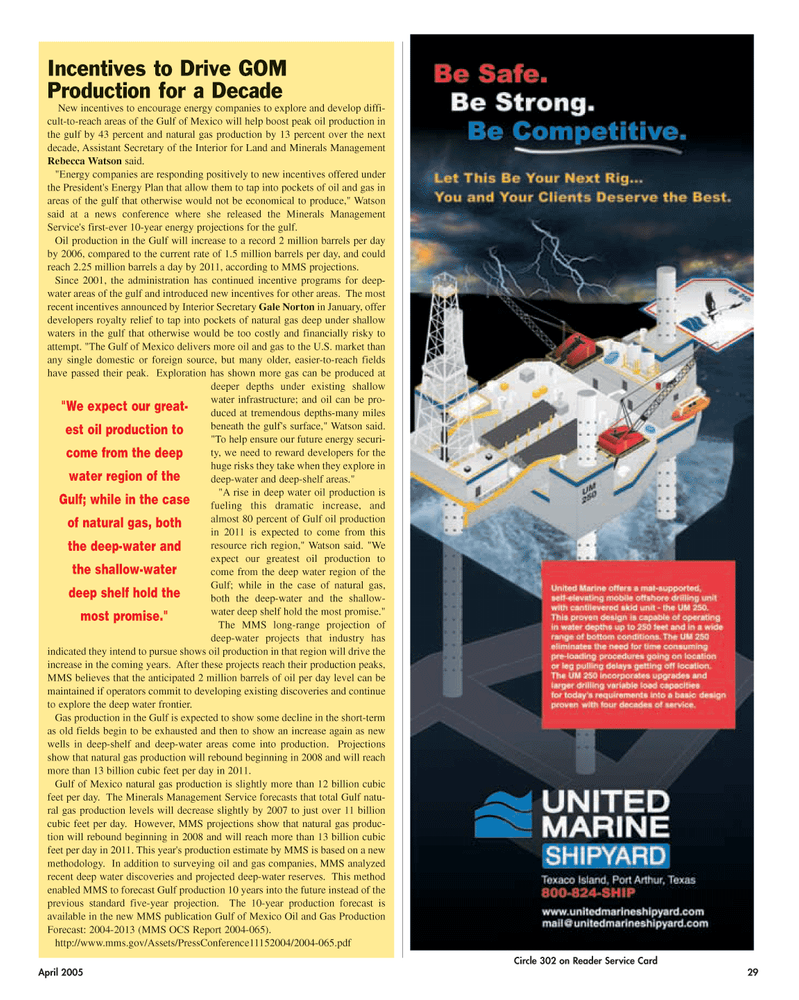
Page 29: of Maritime Reporter Magazine (April 2005)
The Offshore Industry Anual
Read this page in Pdf, Flash or Html5 edition of April 2005 Maritime Reporter Magazine
Circle 302 on Reader Service Card
April 2005 29
Incentives to Drive GOM
Production for a Decade
New incentives to encourage energy companies to explore and develop diffi- cult-to-reach areas of the Gulf of Mexico will help boost peak oil production in the gulf by 43 percent and natural gas production by 13 percent over the next decade, Assistant Secretary of the Interior for Land and Minerals Management
Rebecca Watson said. "Energy companies are responding positively to new incentives offered under the President's Energy Plan that allow them to tap into pockets of oil and gas in areas of the gulf that otherwise would not be economical to produce," Watson said at a news conference where she released the Minerals Management
Service's first-ever 10-year energy projections for the gulf.
Oil production in the Gulf will increase to a record 2 million barrels per day by 2006, compared to the current rate of 1.5 million barrels per day, and could reach 2.25 million barrels a day by 2011, according to MMS projections.
Since 2001, the administration has continued incentive programs for deep- water areas of the gulf and introduced new incentives for other areas. The most recent incentives announced by Interior Secretary Gale Norton in January, offer developers royalty relief to tap into pockets of natural gas deep under shallow waters in the gulf that otherwise would be too costly and financially risky to attempt. "The Gulf of Mexico delivers more oil and gas to the U.S. market than any single domestic or foreign source, but many older, easier-to-reach fields have passed their peak. Exploration has shown more gas can be produced at deeper depths under existing shallow water infrastructure; and oil can be pro- duced at tremendous depths-many miles beneath the gulf's surface," Watson said. "To help ensure our future energy securi- ty, we need to reward developers for the huge risks they take when they explore in deep-water and deep-shelf areas." "A rise in deep water oil production is fueling this dramatic increase, and almost 80 percent of Gulf oil production in 2011 is expected to come from this resource rich region," Watson said. "We expect our greatest oil production to come from the deep water region of the
Gulf; while in the case of natural gas, both the deep-water and the shallow- water deep shelf hold the most promise."
The MMS long-range projection of deep-water projects that industry has indicated they intend to pursue shows oil production in that region will drive the increase in the coming years. After these projects reach their production peaks,
MMS believes that the anticipated 2 million barrels of oil per day level can be maintained if operators commit to developing existing discoveries and continue to explore the deep water frontier.
Gas production in the Gulf is expected to show some decline in the short-term as old fields begin to be exhausted and then to show an increase again as new wells in deep-shelf and deep-water areas come into production. Projections show that natural gas production will rebound beginning in 2008 and will reach more than 13 billion cubic feet per day in 2011.
Gulf of Mexico natural gas production is slightly more than 12 billion cubic feet per day. The Minerals Management Service forecasts that total Gulf natu- ral gas production levels will decrease slightly by 2007 to just over 11 billion cubic feet per day. However, MMS projections show that natural gas produc- tion will rebound beginning in 2008 and will reach more than 13 billion cubic feet per day in 2011. This year's production estimate by MMS is based on a new methodology. In addition to surveying oil and gas companies, MMS analyzed recent deep water discoveries and projected deep-water reserves. This method enabled MMS to forecast Gulf production 10 years into the future instead of the previous standard five-year projection. The 10-year production forecast is available in the new MMS publication Gulf of Mexico Oil and Gas Production
Forecast: 2004-2013 (MMS OCS Report 2004-065). http://www.mms.gov/Assets/PressConference11152004/2004-065.pdf "We expect our great- est oil production to come from the deep water region of the
Gulf; while in the case of natural gas, both the deep-water and the shallow-water deep shelf hold the most promise."
MR APRIL 2005 #4 (25-32).qxd 4/4/2005 9:12 AM Page 29

 28
28

 30
30
